English: Catalogue Entry:
Eckersberg spent 1811 to 1812 in the studio of David, practicing life drawing and history painting. One of a series of subjects from the Odyssey, this is perhaps the most compelling. The giant Polyphemus in his cave looms over a sheep, searching for Ulysses and his companions, who blinded the one-eyed monster. The men have escaped beneath the bellies of the flock; Ulysses, at the end, prepares to join his companions. The Mediterranean light is dazzling. We viewers remain imprisoned in the tenebrous foreground as Ulysses slips away. Eckersberg’s study of the eloquent contours of Greek vase painting is put to good use here.
Although the Danish artist was in Paris to learn from David, the most revered teacher in Europe at the time, his ambivalence can be read in some of the anti-classical tendencies seen here. The disjunction of the large-scale giant Polyphemus and the small Ulysses is true to the story, but disturbing, while the extremes of dark and light add to the monster’s menace. Eckersberg was the citizen of a French ally in the Napoleonic Wars, but as a protégé of the king of Denmark, who underwrote his studies in France and later travels to Italy, and with whose heir he carried on a friendly correspondence, he may well have had mixed feelings about David, a regicide who had cast his vote for the death of Louis XVI. Eckersberg’s letters show he found Paris and its conventions an uncomfortable fit. Although David considered Eckersberg talented and encouraged his studies, this raw and frank history painting expresses a sensibility different from that of his more stylish French students.
Gallery Label:
This is one of a series of paintings and drawings that Eckersberg made in Paris, depicting episodes from Homer’s Odyssey. Ulysses and his companions have blinded the giant Polyphemus, who had been holding them captive in his cave; Ulysses, the last to escape (by tying himself to the underside of a sheep), dismounts and prepares to run away. Eckersberg studied first in Copenhagen and then in Paris with the eminent painter Jacques-Louis David, and this work reflects study of the nude in the life-drawing classes that were the primary focus of David’s training. It also showcases Eckersberg’s interest in perspective, his acute observation of nature, and his nuanced treatment of light. After his stay in Paris, Eckersberg spent three years in Rome before returning to Copenhagen, where he influenced the next generation of artists and became known as the Father of Danish Painting.





